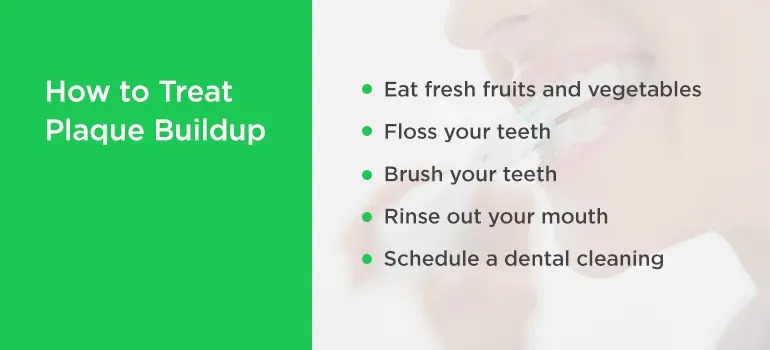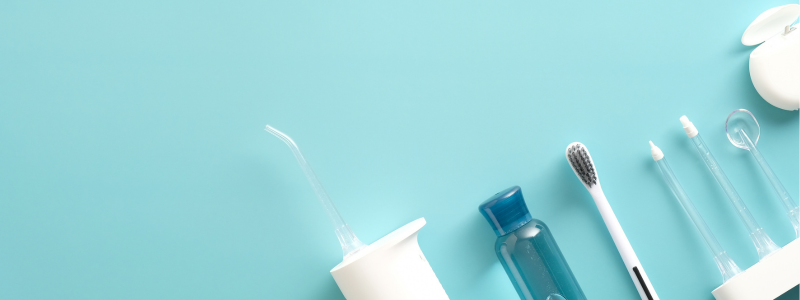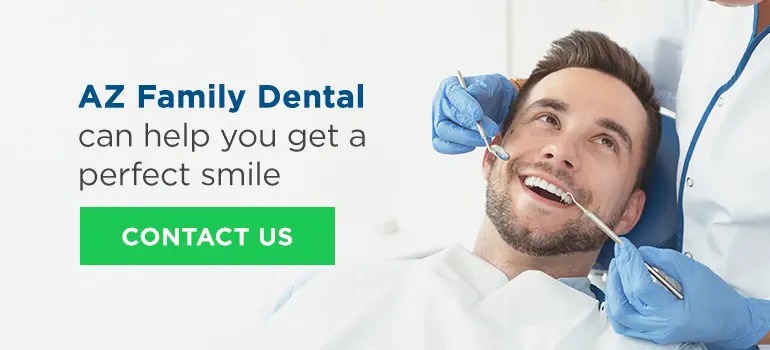
Reviewed and approved by Dr. Matt Parker, D.M.D.
In this blog on how to prevent tooth plaque, we’ll look at the following:
- What causes plaque to build up?
- How to prevent plaque buildup
- How to treat plaque buildup
- Frequently asked questions for preventing tooth plaque
What Causes Plaque to Build Up?
The saliva in your mouth starts to break down simple sugars from your food before you swallow. When you eat foods high in carbohydrates, they react with bacteria in your mouth to begin the formation of plaque on your teeth and inner cheeks. When you brush your teeth, you can remove some of this plaque.
Tooth plaque can build up if you don’t brush your teeth at least twice daily. In a matter of hours, this buildup can result in tartar, a hard, pale yellow substance that causes gum diseases like gingivitis and cavities. Tartar breaks down the enamel on your teeth and causes tooth decay. You should prevent the buildup of plaque before it turns into tartar, which can only be removed by the dentist.
How to Prevent Plaque Buildup
You may detect plaque buildup if you feel a transparent, sticky film on your teeth. The following are some preventive steps you can take to reduce bacteria in your mouth and manage this buildup:
Think about the food and drinks you consume
Plaque feeds on starches from acidic and sugary foods, such as soda and potato chips. While you don’t have to eliminate sugar and acids from your diet, you should be careful about what you eat and drink.
Drinking soda occasionally is acceptable, but having a can with every meal could erode your teeth. Instead, drink water and eat a balance of healthy proteins and starches. The American Dental Hygienists’ Association recommends eating foods rich in calcium and vitamin D to maintain healthy, clean teeth.
Brush your teeth at least twice a day
When you brush your teeth for two minutes twice a day, you can remove plaque from your mouth. Use anti-plaque toothpaste with fluoride and an electric toothbrush that can reach every angle in your mouth. You should change out your brush or the head of your electric brush every three months or when you start to notice the bristles fraying.
Floss at least once a day
Add flossing to your routine to remove the food that may be stuck between your teeth. You should floss before you brush so the food between your teeth doesn’t spread plaque to the rest of your mouth. If you haven’t flossed in a while, you might bleed at first, but the bleeding will stop after you’ve made it a routine.
Use string floss or a water flosser to clean out the gaps between the front and rear of your teeth. If you’re not sure how to floss properly, the dentist can answer any questions you may have.
Use mouthwash as suggested
If you want to eliminate bad breath caused by bacteria, rinse your mouth with mouthwash. The dentist can recommend a brand to help you take care of your teeth. Follow the instructions on the bottle for optimal protection against tooth plaque buildup.
Drink water with fluoride
Fluoride is the active ingredient in toothpaste that guards against the buildup of plaque. Some Arizona cities add fluoride to their water supply to support healthy teeth. Find out if your local water supply contains fluoride, and drink a healthy amount of water each day.
Keep up with your dental appointments
While brushing your teeth at home is essential, you should also schedule regular appointments with the dentist. At the office, the dentist can perform a dental cleaning to remove the bacteria from your teeth and gumline.
They also have mirrors that help them spot plaque in hard-to-reach places. Your dentist can give you personalized recommendations for the best ways to take care of your teeth and answer any questions you may have.
Correct issues with your teeth
If you have crooked teeth, you have a higher chance of getting food stuck in them. They may also be more difficult to brush. To mitigate these risks, you can seek corrective solutions, like braces or invisible aligners. Dental sealants can also prevent up to 80% of cavities for two years and 50% for four years. During your next visit, ask the dentist about protecting your teeth with dental sealants.

How to Treat Plaque Buildup
Plaque buildup is common and should be addressed promptly to prevent you from developing more severe issues from poor oral hygiene. If you notice a sticky film on your teeth, you can get rid of the bacteria in your mouth with these practices:
Eat fresh fruits and vegetables
Saliva produced when chewing can wash away the bacteria in your mouth. Eat crunchy vegetables, like celery or carrots, to treat plaque buildup. You can also chew on a piece of sugar-free or mint gum for the same effect.
Floss your teeth
Flossing twice a day can remove pieces of food stuck between your teeth. Bacteria buildup can cause gum disease and tooth decay, but dental floss allows you to reach and clean areas that are inaccessible to toothbrushes.
Brush your teeth
Dentists have found that toothpaste with baking soda is effective in tooth plaque removal. Your dentist may recommend a special, plaque-fighting toothpaste if you experience a lot of plaque buildup. Make sure you brush your teeth at a 45-degree angle from the gum line and use your toothbrush to clean your tongue.
Rinse out your mouth
You should use mouthwash after each time you brush your teeth to maintain fresh breath. Your dentist may recommend a mouthwash with active ingredients that fight against plaque if necessary.
Schedule a dental cleaning
While you can maintain your oral health at home by brushing and flossing, the dentist can remove tartar buildup and diagnose any gum disease or tooth decay.
Frequently Asked Questions for Preventing Tooth Plaque

Plaque is a sticky film that comes from leftover food particles and saliva. If you don’t brush correctly and on a regular basis, plaque builds up and eats away at the enamel of your teeth, leading to cavities and decay. A consistent, effective oral hygiene routine is the key to halting dental plaque buildup. This includes the following practices:
– Brush your teeth and gums twice daily or after each meal
– Floss once daily
– Rinse with an antiseptic mouthwash
– Visit your dentist at least twice a year
– Avoid smoking and other tobacco products
The types of foods and beverages you consume can contribute to quicker plaque and tatar buildup. Minimize high sugar content if you notice a lot of plaque on your teeth. Mouth bacteria love foods high in carbohydrates and will produce acidic plaque as a result.
Likewise, if you’re not keeping up with brushing and flossing, plaque can continue to form and spread bacteria across your teeth. If the issue persists even with brushing twice and flossing once daily, incorporate anti-bacterial mouthwash into your routine as an added measure.
Consistent brushing and flossing your teeth will prevent plaque from building up and causing infections. As important as brushing is, flossing is equally necessary to remove hard-to-reach plaque between teeth. Make sure you’re using a good brand of toothpaste that contains cavity-preventing fluoride.
Naturally prevent plaque buildup on your teeth by brushing twice daily using fluoride toothpaste and flossing once daily. Toothpaste with ingredients like baking soda or coconut oil is another excellent way to keep your teeth clean naturally at home.
The only way to get rid of plaque buildup is to be proactive in your oral health. When left alone for too long, plaque eventually gets hardened into tartar, leading to tooth decay and gum disease. You can reduce plaque buildup and the speed at which it develops with lifestyle changes such as the amount of sugar you consume.
You should be removing plaque from your teeth regularly, following the routine of brushing twice daily and flossing once daily. For added measure, you can also brush following each meal; just don’t overdo it because this can lead to bleeding gums and soreness. In the same way, schedule dental checkups twice a year for basic cleanings and inspections.

Published On: June 5, 2020
Updated On: September 11, 2023
